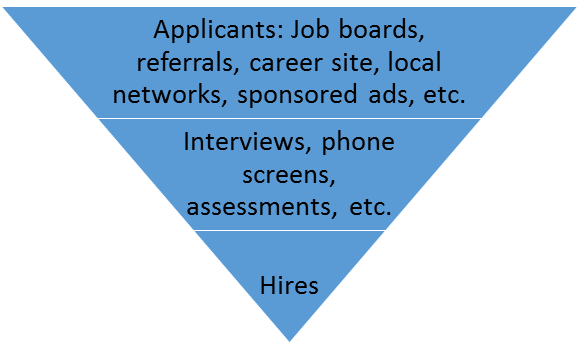I’d love to say that I am perfect and haven’t ever made a mistake in my career, but we all know that just isn’t the case. While this isn’t like the time I set an ATM on fire, it is one of those moments that I relive over and over again with more than a little remorse. See if you can learn any lessons from my own experience…
 Years ago I was recruiting for technical writers to join a growing team that I was putting together to support a government contract. Instead of the usual ones and twos, I was hiring a dozen people for this position at one time. It wasn’t your run of the mill tech writer opening, either. I was looking for people with experience writing to military specifications. I needed writers that could do some illustrations. I also needed at least one of the hires to know how to be a “provisioner,” the hardest job I’ve ever had to fill (yes, even harder than helicopter instructor pilots).
Years ago I was recruiting for technical writers to join a growing team that I was putting together to support a government contract. Instead of the usual ones and twos, I was hiring a dozen people for this position at one time. It wasn’t your run of the mill tech writer opening, either. I was looking for people with experience writing to military specifications. I needed writers that could do some illustrations. I also needed at least one of the hires to know how to be a “provisioner,” the hardest job I’ve ever had to fill (yes, even harder than helicopter instructor pilots).
The skill set was very obscure, and I had to sift through tons of unqualified resumes to find the few that were a good fit. All this was capped off by an unreasonable deadline set by the customer–a surefire recipe for disaster.
Despite all of the things working against me, I was feeling pretty confident. We had an employee referral or two, and since it is a relatively tight community, I was able to get feedback on some candidates to know which would be a good fit and which wouldn’t before investing time into building rapport with each. I had a great first round of interviews with our pool of applicants, and we were moving a good number of them forward to talk with the hiring manager and the technical lead on the team.
I was working long hours, as I usually did during heavy recruiting seasons of the year. As with many small companies, I was wearing all of the HR hats, and recruiting was one of many of my duties. When a big effort spun up, it would put other things on hold, no matter how critical they might be. I’ll never forget trying to set up a performance improvement plan for a staff member, investigate another for harassment, and try to find a pilot to go to Hawaii for a year-long contract. I survived those hectic weeks purely on Diet Mountain Dew, which I no longer consume.
Anyway, I was working hard. One thing that I have always felt was a differentiator for me as a recruiter and HR leader was that I put the extra effort into communications, and it had paid off. I got massive results from my LinkedIn invitations to candidates. I had high readership and engagement from internal staff on HR communications I developed. I knew that skill set, while it took time that could be used on other activities, was going to continue paying dividends over time. But one day, for some reason, I snapped.
Yes, I snapped. If you’ve ever met me in person, you’d have a hard time believing I could snap at anything. And yet I did.Â
One of the candidates I was chasing for the final slot had been leading me on and was slowly becoming less responsive as the days went by. I thought I might be losing him, but despite everything I put into every conversation, there didn’t seem to be a way to turn it around.
Finally I asked him point blank what the issue was. Why was he backing off? Was there something I could do to fix it?
And the guy responded with something that drove me over the edge.
He said that he had heard the company wasn’t very good to its employees and that he wasn’t interested in working at a place like that.
And it happened. I. Went. Off.Â
Now, before I tell you what I said, I want you to understand something. I had worked for the company since it was a startup. I knew every employee and spouse by name, and I was pretty darn good about knowing their kids, too. People loved the company and the work. We had phenomenal leadership and a great mission. We prided ourselves in taking care of our people financially, professionally, and personally.
One time, an employee’s house blew away in a tornado on his first day of work. We all pitched in to make sure he had leave to cover his time away with his family to pick up the pieces. We really worked hard to take care of these people just like they were family. I agonized over absolutely every detail to make sure the company was the kind of place that I would be proud of my own kids working for. I had employees from our partner companies calling me daily asking how they could join our team because our employees were so darn happy with their jobs and the company.
And this guy had the nerve to lie and say that we didn’t care.Â
I responded back to the guy and told him that after reviewing his resume, I didn’t think he was a good fit for the company. Now, or ever. We didn’t need people like him on the team anyway. Good riddance. So long, jerk…
And you know what? I felt great! It was so awesome to get that off my chest.
For about five minutes.
Then I realized I had just treated this guy the way that the fictional company he imagined us to be would have done. And I am still kicking myself all these years later for doing it and proving him right.
Within half an hour I sent an apology, attempting to salvage the contact for future efforts even though I knew it was probably toast. The next morning I immediately went to my boss and explained what I had done, telling her that I had even apologized after the fact. She knew that I was going to beat myself up about it worse than anything she could do, so she let me off the hook.
What’s the lesson here? The moral of the story? Well, we all know that we should never respond to anyone, in any situation, in a spirit of anger. That time it got the best of me. I also learned that I should never respond to emotionally-charged situations via email on my cell phone, because I tend to be more direct and less concerned with the message in general when I’m responding via that method. Painful reminders that stick with me to this very day. The final one is to try and keep stress from getting to you. Yes, it’s easier said than done, but we all know it never leads to positive outcomes.
Oh, and in case you’re wondering, the guy never replied back to anything. I never talked with him again, and I can’t even remember his name at this point. But I will never forget where I was and what I was doing when I read that note from him. Or how it felt when I realized what I had done.
Over the years I’ve recruited many, many more people. I’ve never again responded to any of them, no matter the situation, in anger or in a way that would embarrass the company or myself. That was a painful lesson to learn and one that still haunts me when I think about it, but I am glad to know that it only took one instance to make it stick with me.
Ever done anything embarrassing as an HR or recruiting pro? Feel free to respond anonymously in the comments.Â

 Years ago I was recruiting for technical writers to join a growing team that I was putting together to support a government contract. Instead of the usual ones and twos, I was hiring a dozen people for this position at one time. It wasn’t your run of the mill tech writer opening, either. I was looking for people with experience writing to military specifications. I needed writers that could do some illustrations. I also needed at least one of the hires to know how to be a “provisioner,” the hardest job I’ve ever had to fill (yes, even harder than helicopter instructor pilots).
Years ago I was recruiting for technical writers to join a growing team that I was putting together to support a government contract. Instead of the usual ones and twos, I was hiring a dozen people for this position at one time. It wasn’t your run of the mill tech writer opening, either. I was looking for people with experience writing to military specifications. I needed writers that could do some illustrations. I also needed at least one of the hires to know how to be a “provisioner,” the hardest job I’ve ever had to fill (yes, even harder than helicopter instructor pilots). When I was recruiting, I wanted to find out from the candidate early on, whether through a job application question or through an informal conversation, what sort of salary range they were looking for. If it wasn’t offered, I would share the range of the opening early in the process. Was I showing my cards? Yes. But I was also attempting to conserve a valuable resource: time.
When I was recruiting, I wanted to find out from the candidate early on, whether through a job application question or through an informal conversation, what sort of salary range they were looking for. If it wasn’t offered, I would share the range of the opening early in the process. Was I showing my cards? Yes. But I was also attempting to conserve a valuable resource: time. 